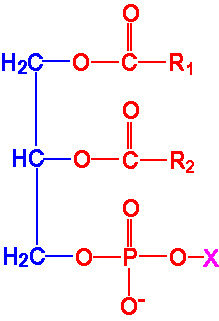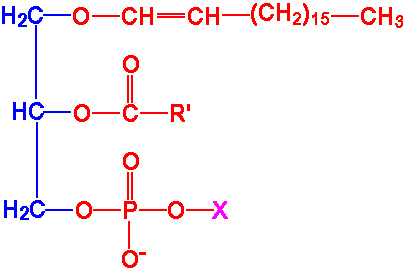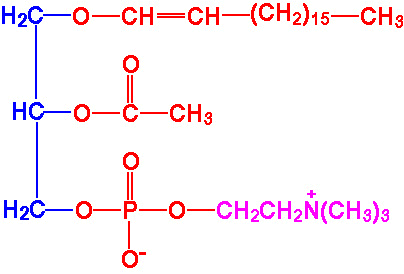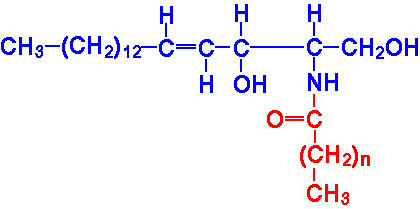Major Roles of Biological of Lipids
Biological molecules that are insoluble in aqueous solutions and soluble in
organic solvents are classified as lipids. The lipids of physiological
importance for humans have four major functions:
- 1. They serve as structural components of biological membranes.
- 2. They provide energy reserves, predominantly in the form of
triacylglycerols.
- 3. Both lipids and lipid derivatives serve as vitamins and
hormones.
- 4. Lipophilic bile acids aid in lipid solubilization.
back to the
top
Fatty Acids
Fatty acids fill two major roles in the body:
- as the components of more complex membrane lipids.
- as the major components of stored fat in the form of
triacylglycerols.
Fatty acids are long-chain hydrocarbon molecules containing a carboxylic
acid moiety at one end. The numbering of carbons in fatty acids begins with the
carbon of the carboxylate group. At physiological pH, the carboxyl group is
readily ionized, rendering a negative charge onto fatty acids in bodily fluids.
Fatty acids that contain no carbon-carbon double bonds are termed saturated fatty acids; those that contain double bonds are
unsaturated fatty acids. The numeric designations
used for fatty acids come from the number of carbon atoms, followed by the
number of sites of unsaturation (eg, palmitic acid is a 16-carbon fatty acid
with no unsaturation and is designated by 16:0). The site of unsaturation in a
fatty acid is indicated by the symbol D and the number of the first carbon of the double
bond (e.g. palmitoleic acid is a 16-carbon fatty acid with one site of
unsaturation between carbons 9 and 10, and is designated by 16:1D9).
Saturated fatty acids of less than eight carbon atoms are liquid at
physiological temperature, whereas those containing more than ten are solid. The
presence of double bonds in fatty acids significantly lowers the melting point
relative to a saturated fatty acid.
The majority of body fatty acids are acquired in the diet. However, the
lipid biosynthetic capacity of the body (fatty acid synthase and other fatty
acid modifying enzymes) can supply the body with all the various fatty acid
structures needed. Two key exceptions to this are the highly unsaturated fatty
acids know as linoleic acid and linolenic acid, containing unsaturation sites beyond
carbons 9 and 10. These two fatty acids cannot be synthesized from precursors in
the body, and are thus considered the essential fatty
acids; essential in the sense that they must be provided in the diet.
Since plants are capable of synthesizing linoleic and linolenic acid humans can
aquire these fats by consuming a variety of plants or else by eating the meat of
animals that have consumed these plant fats.
back to the
top
Physiologically Relevant Fatty Acids
| Numerical
Symbol |
Common Name |
Structure |
Comments |
| 14:0 |
Myristic acid |
CH3(CH2)12COOH |
Often found attached to the N-term. of
plasma membrane-associated cytoplasmic proteins |
| 16:0 |
Palmitic acid |
CH3(CH2)14COOH |
End product of mammalian fatty acid
synthesis |
| 16:1D9 |
Palmitoleic acid |
CH3(CH2)5C=C(CH2)7COOH |
|
| 18:0 |
Stearic acid |
CH3(CH2)16COOH
| |
| 18:1D9 |
Oleic acid |
CH3(CH2)7C=C(CH2)7COOH
| |
| 18:2D9,12 |
Linoleic acid |
CH3(CH2)4C=CCH2C=C(CH2)7COOH |
Essential fatty
acid |
| 18:3D9,12,15 |
Linolenic acid |
CH3CH2C=CCH2C=CCH2C=C(CH2)7COOH |
Essential fatty
acid |
| 20:4D5,8,11,14 |
Arachidonic acid |
CH3(CH2)3(CH2C=C)4(CH2)3COOH |
Precursor for eicosanoid
synthesis |
back to
the top
Basic Structure of Triacylglycerides
Triacylglycerides are composed of a glycerol backbone to which 3 fatty acids
are esterified.
 |
| Basic composition of a
triacylglyceride. The glycerol backbone is in
blue. |
back to the
top
Basic Structure of Phospholipids
The basic structure of phospolipids is very similar to that of the
triacylglycerides except that C-3 (sn3)of the glycerol backbone is
esterified to phosphoric acid. The building block of the phospholipids is
phosphatidic acid which results when the X
substitution in the basic structure shown in the Figure below is a hydrogen
atom. Substitutions include ethanolamine (phosphatidylethanolamine), choline (phosphatidylcholine, also called lecithins), serine (phosphatidylserine), glycerol (phosphatidylglycerol), myo-inositol (phosphatidylinositol, these compounds can have a variety
in the numbers of inositol alcohols that are phosphorylated generating polyphosphatidylinositols), and phosphatidylglycerol (diphosphatidylglycerol more commonly known as cardiolipins).
 |
| Basic composition of a
phospholipid. X can be a number of different
substituents. |
back to the
top
Basic Structure of Plasmalogens
Plasmalogens are complex membrane lipids that resemble phospholipids,
principally phosphatidylcholine. The major difference is that the fatty acid at
C-1 (sn1) of glycerol contains either an O-alkyl or
O-alkenyl ether species. A basic O-alkenyl ether species is shown
in the Figure below. One of the most potent biological molecules is platelet activating factor (PAF) which is a choline
plasmalogen in which the C-2 (sn2) position of glycerol is esterified
with an acetyl group insted of a long chain fatty acid.
 |
 |
Top: basic composition of
O-alkenyl plasmalogens.
Bottom: structure of
PAF. |
back to the
top
Basic Structure of Sphingolipids
Sphingolipids are composed of a backbone of sphingosine which is derived
itself from glycerol. Sphingosine is N-acetylated by a variety of fatty acids
generating a family of molecules referred to as ceramides. Sphingolipids predominate in the myelin sheath
of nerve fibers. Sphingomyelin is an abundant
sphingolipid generated by transfer of the phosphocholine moiety of
phosphatidylcholine to a ceramide, thus sphingomyelin is a unique form of a
phospholipid.
The other major class of sphingolipids (besides the sphingomyelins) are the
glycosphingolipids generated by substitution of
carbohydrates to the sn1 carbon of the glycerol backbone of a ceramide.
There are 4 major classes of glycosphingolipids:
- Cerebrosides: contain a single moiety,
principally galactose.
- Sulfatides: sulfuric acid esters of
galactocerebrosides.
- Globosides: contain 2 or more sugars.
- Gangliosides: similar to globosides except
also contain sialic acid.
 |
 |
Top: Sphingosine
the atoms in red are derived from glycerol.
Bottom: Basic composition of a ceramide
n indicates any fatty acid may be
N-acetylated at this
position. |
back to
the top
Back to Biomolecules
Back to Topics<<<<
This article has been modified by Dr. M. Javed Abbas.
If you have any comments please do not hesitate to sign my Guest Book.
20:36 21/12/2002
|





